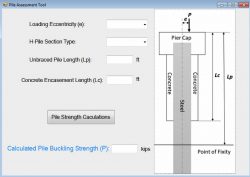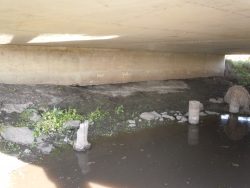InTrans / Mar 17, 2021
Pile assessment tool evaluates steel H-pile capacity


Tool helps engineers make rapid decisions in scour situations
As winter slowly slides into spring, local agencies are beginning to shift their focus from clearing the roads of ice and snow to the coming thaw, and its potential to lead to flooding.
If, or more likely when, flooding comes to Iowa’s communities, it will be up to engineers to make quick—and informed—decisions on whether the rapids are leading to scour and ultimately impacting a bridge’s overall capacity. The Bridge Engineering Center (BEC) has been working for years to develop just such a tool to aid state rating engineers in their decision-making.
“The main benefit is that you can get data-driven, educated decision-making in times of emergency events such as flooding,” said BEC Associate Director Katelyn Freeseman, who is leading a second phase of the project that initially developed the pile assessment tool.
She added, “Tools like this are great because they give you more confidence in making decisions that provide safe infrastructure to the traveling public.”
The tool has a user-friendly graphical interface that requires the input of a few key factors to quickly calculate pile capacity, including taking into account the varying amounts of unbraced pile lengths and the stiffness contribution of concrete encasements, for state rating engineers to make the needed timely decisions on pile capacity and stability.
In addition, rating engineers could use the tool to establish the maximum permissible amount of scour for each pile bent prior to any flood event, since the tool is relatively easy to use.
“Basically, it just allows you to make informed maintenance and closure decisions,” Freeseman said.
The second phase of the project is a laboratory validation of the tool to ensure the experimental data matches the outputs of the tool, or make any tweaks necessary if the two do not align properly.
For more information about the tool, contact Freeseman at kfreese@iastate.edu.
To learn more about the project, see the completed Phase I project page here and stay up to date on the in progress Phase II project here.